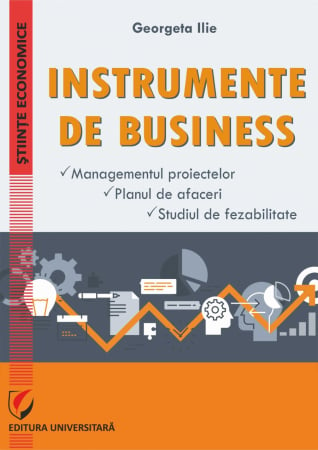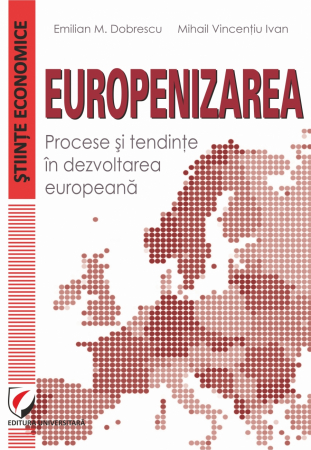ISBN: 978-606-28-0192-2
DOI: 10.5682/9786062801922
Publisher year: 2015
Edition: I
Pages: 260
Publisher: Editura Universitara
Author: Vadim Dumitrascu, Roxana Arabela Dumitrascu
- Description
- Download (1)
- Authors
- Content
- More details
- Where to find it
- Reviews (0)
-
Financial Diagnosis and Evaluation. Conceptual Landmarks, Models and Techniques
Download
Education:
Faculty of Economics, University "Petre Andrei" of Iasi, specializing in Finance and Accounting (2001);
Post-graduate School of the University FIBAS "Al. I. Cuza" Iasi, master's degree in Economics and Financial Management & Banking (2005);
Academy of Economic Studies (2010), PhD in Finance;
Romanian Academy, SPODE, post-doctoral studies in economics.
Activity:
2001-2011 professor at the Faculty of Economics of the University "Petre Andrei" of Iasi;
2012 Ph.D. Lecturer at the Faculty of Finance, Banking and Accounting, of Christian University "Dimitrie Cantemir" of Bucharest, owner of enterprise financial management courses, insurance and reinsurance and risk management in insurance and reinsurance.
Publications:
Single author: Financial management company. Self-study manual (2012), Insurance and reinsurance. Self-study manual (2012), Prices and and competitivity. Self-study manual (2012), Management of the goodwill value (2008).
Coauthor: Intangible firm capital management (2009), Drift Management (2005), Management versus postmodernity (2005), Defiance complexity (2004), Elements of evaluating companies (2002).
Over 70 articles and studies published in scientific journals.
VADIM DUMITRASCU
Chapter 1
Diagnosis and evaluation as foundations of the company's financial strategy
1.1. The content of the company's financial strategy / 11
1.2. Establishing long - term financial objectives / 14
1.3. Typology of financial strategy models at company level / 19
1.4. Application solved / 35
Chapter 2
Diagnosis of the process of creating added economic value
2.1. Determinants of the process of creating added economic value / 38
2.2. Sensitivity of the exploitation result in relation to the variations of the size of the economic asset / 41
2.3. Possibilities to intensify the creation of added economic value / 43
2.3. Application solved / 45
Chapter 3
The complexity of the notion of cash flow
3.1. The relationship between the economic results and the company's treasury / 49
3.2. The size of the cash flow concept / 52
3.3. Cash flow as a synthesis of the company's financial balance / 56
3.4. Approaching cash flow according to destinations / 59
3.5. Solved applications / 61
Chapter 4
Financial performance between profitability and cash flow
4.1. Relevance of profitability as a measure of the financial performance of the company / 67
4.2. Self-financing capacity as a form of profitability / 71
4.3. Sensitivity of self-financing in relation to the variation of the company's activity volume / 74
4.4. Solved applications / 78
Chapter 5
Determining factors of the company's value
5.1. Sources of company value / 85
5.2. Approaching the value of the company based on cash flow / 86
5.3. Company value and investments / 91
Chapter 6
Diagnosis of the company's financial viability
6.1. The conditions of the financial viability of the company / 95
6.2. Determination and meanings of the global treasury sensitivity coefficient / 98
6.3. The relationship between financial viability and company value / 100
Chapter 7
Integrated diagnosis of the company's economic efficiency
7.1. The economic efficiency of the company from an integrated perspective / 103
7.2. Diagnosis of efficiency based on the picture "Effects - Efforts" / 104
7.3. Economic efficiency indicators / 106
Chapter 8
Patrimonial (accounting) methods of valuing the company
8.1. Value for money / 108
8.2. Specific factors for sizing the value of the company / 110
8.3. Net accounting assets (ANC) / 113
8.4. Adjusted net accounting assets (ANCC) / 114
8.5. Substantial values (gross, reduced, net) of the company / 121
8.6. Permanent capitals necessary for operation / 122
8.7. Application resolved / 123
Chapter 9
Profitability valuation methods
9.1. Fundamentals of company profitability evaluation / 128
9.2. Types of company profitability values / 131
9.3. Establishing the value of the company by updating cash flows / 133
9.4. Solved applications / 143
Chapter 10
Hybrid evaluation methods. Evaluating the company through goodwill
10.1. The meanings of the company's goodwill concept / 155
10.2. Evaluation by goodwill: models, techniques and methods / 157
10.3. Combined company evaluation techniques / 160
10.4. Particular techniques and methods for evaluating companies / 162
10.5. Selecting the company evaluation method / 164
10.4. Solved applications / 166
Chapter 11
Evaluation of companies in difficulty
11.1. Significance and symptoms of the company's financial difficulties / 169
11.2. Financial conditions and implications of the company restructuring / 171
11.3. Surveillance and diagnosis of the recovery process of the company in difficulty / 175
11.4. Guidelines on strategies for recovering companies in difficulty / 180
11.5. Techniques for establishing the value of companies in difficulty / 184
11.6. The specifics of the evaluation of viable and deficient activities / 191
11.7. Application solved / 196
Chapter 12
Considerations regarding the strategic value of the company
12.1. Formation of the strategic value of the company / 189
12.2. Intangible assets and strategic positioning of the company / 203
Chapter 13
Intellectual capital valuation (intangible)
13.1. Intellectual capital (intangible): significance, factors, implications / 208
13.2. The components of the intellectual capital of the company / 211
13.3. Measurement (metrics) of intellectual capital / 214
13.4. Qualitative models of the intellectual capital of the company / 220
13.5. Quantitative models of the intellectual capital of the company / 225
13.6. Application solved / 229
Chapter 14
Financial forecasts in conditions of uncertainty
14.1. Model of financial evaluation of the reputation capital of the company / 239
14.2. Using certainty intervals for predictive reputation calculation / 246
14.3. Predictive estimates by fuzzy techniques / 251
Bibliography / 256
We hope that it will not be too difficult for readers to find favorite topics of analysis of efficiency, value and ways of recovery of the company: cash flow, self-financing capacity, goodwill, etc. In this paper we have tried to inspire the life of these financial concepts, approaching them contextually and carefully following the connections and interdependencies with other significant aspects of business operation. The figures acquire meaning and relevance only if they are interpreted in correlation with the multireferential and multidimensional reality of the company.
The profound structural changes that have taken place in the world economy as well as in the national one - globalization, dematerialization, crisis, etc. - urges us to look critically not only at managerial practices at different organizational levels of the economy, but also at the theoretical scaffolding that inspired them. The "decorporalization" of processes and economic value exerts particularly pressing effects in the sense of re-examining the concepts and theoretical models of most management sciences. The financial management of the enterprise not only is not an exception, but, on the contrary, is at the forefront of this conceptual innovation, as it is the field that has taken on the mission of answering some fundamental questions: What is currently the economic value and, in consequence, the value of the business (enterprise)?; What are the main factors (inducers) of business value ?; What are the means to stimulate the growth of business value? Of course, the issue of financial management is much more complex, but we must recognize that the other concerns are, directly or indirectly, only derivatives subordinated to these three crucial issues, and the dematerialization of the economy forces us to revise, sometimes even radically, traditional perspectives on them. The interest for the study of goodwill as a tool for diagnosis, evaluation and restructuring of business is generated and is in the area of these concerns: it is increasingly clear that an increasing part of the value of modern companies is intangible, goodwill representing the global financial approximation of the intangible capital held by enterprises.
The Authors
Customer Support Monday - Friday, between 8.00 - 16.00
0745 200 718 0745 200 357 comenzi@editurauniversitara.ro
6359.png)
![Financial Diagnosis and Evaluation. Conceptual Landmarks, Models and Techniques [1] Financial Diagnosis and Evaluation. Conceptual Landmarks, Models and Techniques [1]](https://gomagcdn.ro/domains/editurauniversitara.ro/files/product/large/diagnostic-financiar-si-evaluare-repere-conceptuale-modele-si-tehnici-830-383649.jpg)














